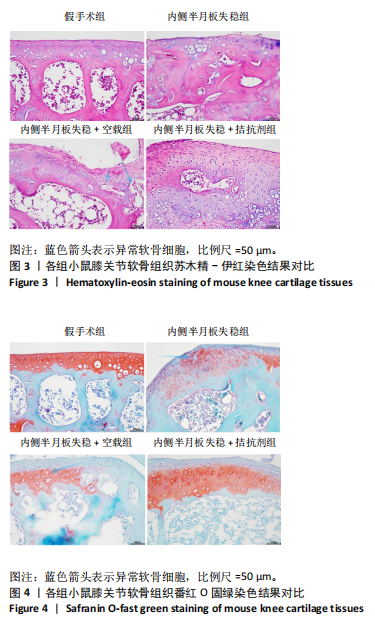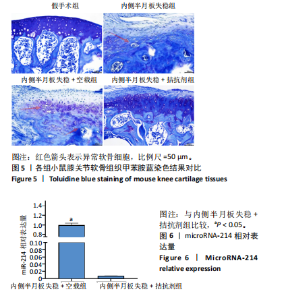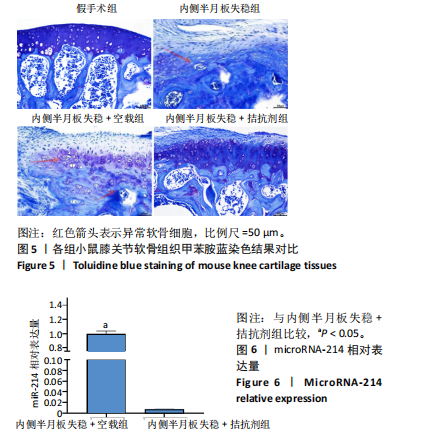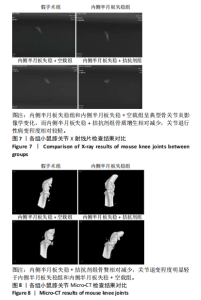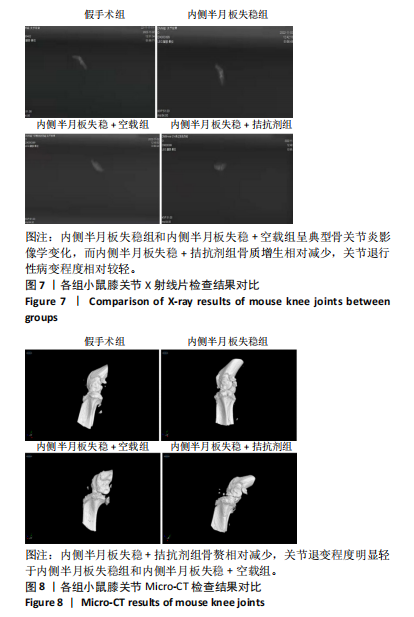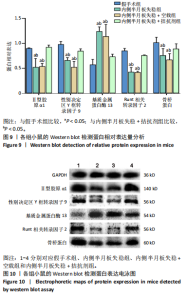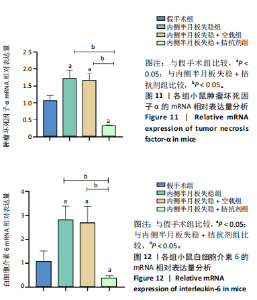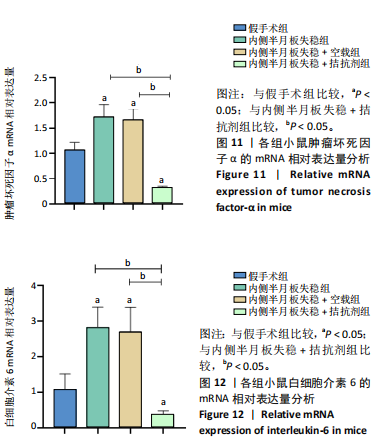Chinese Journal of Tissue Engineering Research ›› 2025, Vol. 29 ›› Issue (12): 2466-2474.doi: 10.12307/2025.389
Previous Articles Next Articles
Mechanism underlying microRNA-214 regulation of cartilage and subchondral bone metabolism in osteoarthritis
Tian Sheng1, Wang Xi2, 3, Wang Yongcheng4, Liu Yaning3, Yang Hongquan1
- 1Graduate School of Baotou Medical College, Inner Mongolia University of Science and Technology, Baotou 014000, Inner Mongolia Autonomous Region, China; 2Guang’an District People’s Hospital of Guang’an City, Guang’an 638000, Sichuan Province, China; 3Inner Mongolia Medical University, Hohhot 010000, Inner Mongolia Autonomous Region, China; 4Orthopedic Center, Inner Mongolia People’s Hospital, Hohhot 010000, Inner Mongolia Autonomous Region, China
-
Received:2024-03-19Accepted:2024-06-07Online:2025-04-28Published:2024-09-09 -
Contact:Wang Yongcheng, MD, Chief physician, Master’s supervisor, Orthopedic Center, Inner Mongolia People’s Hospital, Hohhot 010000, Inner Mongolia Autonomous Region, China -
About author:Tian Sheng, Master candidate, Graduate School of Baotou Medical College, Inner Mongolia University of Science and Technology, Baotou 014000, Inner Mongolia Autonomous Region, China -
Supported by:Inner Mongolia Natural Science Foundation, No. 2020MS08054 (to WYC); Joint Project of Inner Mongolia Medical University, No. YKD2021LH037 (to WYC); 2022 Autonomous Region Health and Wellness Science and Technology Program Project, No. 202201013 (to WYC)
CLC Number:
Cite this article
Tian Sheng, Wang Xi, Wang Yongcheng, Liu Yaning, Yang Hongquan. Mechanism underlying microRNA-214 regulation of cartilage and subchondral bone metabolism in osteoarthritis[J]. Chinese Journal of Tissue Engineering Research, 2025, 29(12): 2466-2474.
share this article
Add to citation manager EndNote|Reference Manager|ProCite|BibTeX|RefWorks
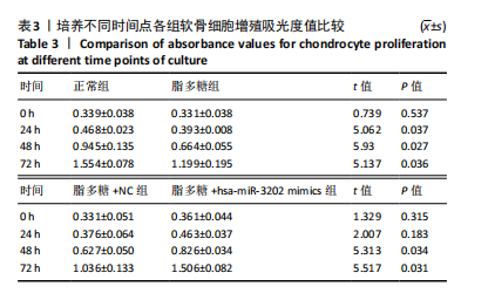
2.1 实验动物数量分析 30只小鼠全部进入结果分析,无脱失。 2.2 实验一结果 2.2.1 苏木精-伊红染色结果 假手术组软骨基质染色均匀,软骨细胞分布均匀,潮线完整,软骨细胞形态饱满,胞质、胞核清晰可辨认;内侧半月板失稳组软骨基质着色不均,潮线不规则,可见纤维化,软骨细胞形态异常,排列紊乱,大小不均。见图1。 2.2.2 荧光定量PCR实验结果 见图2。 以U6作为内参,假手术组与内侧半月板失稳组软骨细胞中均有miR-214表达,且存在差异表达。与假手术组比较,内侧半月板失稳组中miR-214的表达水平明显高于假手术组(2.163 6±0.254 3 vs. 1.006 6±0.121 4,P < 0.05)。 2.3 实验二结果 2.3.1 苏木精-伊红染色实验结果 术后4周取各组标本进行组织学染色,镜下显示,假手术组染色显示软骨基质染色均匀,软骨细胞分布均匀,潮线完整,软骨细胞形态饱满,胞质、胞核清晰可辨认;经内侧半月板胫侧副韧带离断手术建立骨关节炎模型后,膝关节软骨细胞增生,内侧半月板失稳组可见大量空泡细胞,细胞形态异常,排列紊乱,分布不均,数量减少,潮线破坏,软骨组织变薄,表示软骨退变;内侧半月板失稳+空载组软骨组织退变情况与内侧半月板失稳组相似,而内侧半月板失稳+拮抗剂组中软骨退变程度较内侧半月板失稳组明显减轻,细胞外基质保留相对较好。见图3。 2.3.2 番红O固绿染色结果 术后4周取各组标本经番红O固绿染色后镜下显示,假手术组软骨基质染色均匀,软骨细胞分布均匀,软骨细胞形态饱满,胞质、胞核清晰可辨认;建立小鼠骨关节炎模型后,内侧半月板失稳组可见大量空泡细胞,细胞形态异常,排列紊乱,分布不均,数量减少,表示软骨退变;内侧半月板失稳组中软骨基质丢失最严重,内侧半月板失稳+空载组软骨组织退变情况与内侧半月板失稳组相似,而内侧半月板失稳+拮抗剂组细胞外基质保留相对较多。见图4。 2.3.3 甲苯胺蓝染色结果 术后4周各组取材染色后,镜下显示,内侧半月板失稳组膝关节软骨完整性被破坏,可见大量空泡细胞,细胞形态异常,排列紊乱,分布不均,数量减少,软骨组织变薄,表示软骨退变。假手术组软骨细胞基质染色均匀,软骨细胞分布均匀、形态饱满;内侧半月板失稳组中软骨退变程度最严重;内侧半月板失稳+空载组软骨组织退变情况与内侧半月板失稳组相似,而内侧半月板失稳+拮抗剂组细胞外基质保留相对较好。见图5。 2.3.4 腺病毒验证PCR检测结果 验证结果显示,miR-214目的基因在内侧半月板失稳+空载组和内侧半月板失稳+拮抗剂组中的相对表达量有差异;与内侧半月板失稳+拮抗剂组比较,内侧半月板失稳+空载组miR-214在骨关节炎小鼠关节软骨中表达量明显更高,差异有显著性意义(P < 0.05)。这表明使用腺病毒作为载体,miR-214拮抗剂可以达到预期效果。见图6。 2.3.5 影像学X射线片分析与Micro-CT检查结果 X射线片检测结果显示,假手术组小鼠膝关节无明显异常;内侧半月板失稳组和内侧半月板失稳+空载腺组小鼠关节间隙狭窄,边缘骨赘形成,呈典型骨关节炎影像学变化;内侧半月板失稳+拮抗剂组骨质增生相对减少,关节退行性病变程度相对较轻。见图7。 造模术后4周各组取1只小鼠进行Mirco-CT检查,Micro-CT检测结果显示,与假手术组比较,内侧半月板失稳组、内侧半月板失稳+空载组各项整体数据较差,反映出骨关节炎小鼠存在软骨下骨异常骨重塑,造成骨质丢失。内侧半月板失稳+ 拮抗剂组在注入miR-214拮抗剂后,各项数据整体好于内侧半月板失稳组及内侧半月板失稳+空载组,差异有显著性意义(P < 0.05)。表示miR-214拮抗剂可以促进软骨下骨重塑,延缓骨关节炎进展。见表3及图8。"
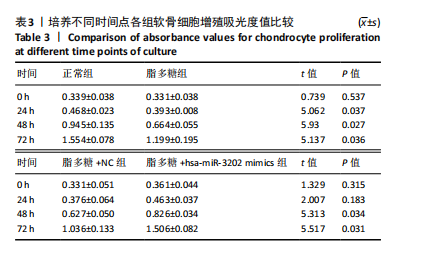
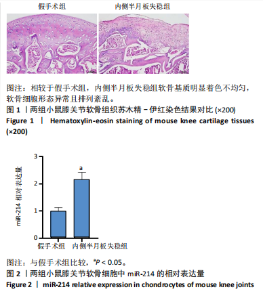
2.3.6 Western blot检测结果 见图9,10。 Western blot检测结果显示,腺病毒干预组注入miR-214拮抗剂1周后,以GAPDH作为内参,内侧半月板失稳组、内侧半月板失稳+空载组软骨标本中Ⅱ型胶原α1、性别决定区Y框转录因子9、Runt相关转录因子2、骨桥蛋白的相对表达水平低于假手术组,差异均有显著性意义(P < 0.05);而基质金属蛋白酶13的相对表达水平在内侧半月板失稳组、内侧半月板失稳+空载组中高于假手术组,差异均有显著性意义(P < 0.05)。内侧半月板失稳+拮抗剂组软骨标本中Ⅱ型胶原α1、性别决定区Y框转录因子9、Runt相关转录因子2、骨桥蛋白的相对表达水平高于内侧半月板失稳组、内侧半月板失稳+空载组(P < 0.05);而基质金属蛋白酶13的相对表达水平在内侧半月板失稳组、内侧半月板失稳+空载组中高于内侧半月板失稳+拮抗剂组,差异均有显著性意义(P < 0.05)。这表示小鼠骨关节炎模型达到形成骨关节炎的预期效果,miR-214拮抗剂起到了延缓骨关节炎进展的作用。 2.3.7 荧光定量PCR检测结果 见图11,12。 荧光定量PCR检测结果显示,与假手术组比较,内侧半月板失稳组、内侧半月板失稳+空载组膝关节"
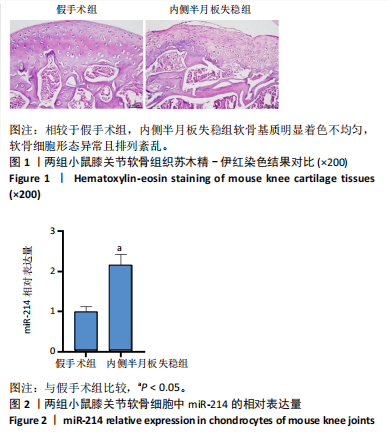
| [1] LIU Y, WU C, CHEN C, et al. Impact of soft tissue around the knee on the efficacy of extracorporeal shockwave therapy in knee osteoarthritis. Medicine. 2022;101(50):e32334. [2] ZECCA PA, REGUZZONI M, PROTASONI M, et al. The chondro-osseous junction of articular cartilage. Tissue Cell. 2023;80:101993. [3] 任鹏玲,牛海军,宫赫,等.老龄关节软骨和软骨下骨的变化及相互作用机制研究进展[J].医用生物力学,2020,35(2):253-258. [4] FUJII Y, LIU L, YAGASAKI L, et al. Cartilage Homeostasis and Osteoarthritis. Int J Mol Sci. 2022;23(11):6316. [5] GU J, RAO W, HUO S, et al. MicroRNAs and long non-coding RNAs in cartilage homeostasis and osteoarthritis. Front Cell Dev Biol. 2022; 10:1092776. [6] 阿布都艾尼•热吾提,肖伟,周文正,等.miR-145对TNF-α诱导人关节软骨细胞增殖凋亡及炎症反应的影响[J].中国骨与关节杂志, 2021,10(7):521-526. [7] TU M, LI Y, ZENG C, et al. MicroRNA-127-5p regulates osteopontin expression and osteopontin-mediated proliferation of human chondrocytes. Sci Rep. 2016;6:25032. [8] MA F, LI G, YU Y, et al. MiR-33b-3p promotes chondrocyte proliferation and inhibits chondrocyte apoptosis and cartilage ECM degradation by targeting DNMT3A in osteoarthritis. Biochem Biophys Res Commun. 2019;519(2):430-437. [9] LI H, LI Z, PI Y, et al. MicroRNA-375 exacerbates knee osteoarthritis through repressing chondrocyte autophagy by targeting ATG2B. Aging. 2020;12(8):7248-7261. [10] WESTACOTT CI, SHARIF M. Cytokines in osteoarthritis: mediators or markers of joint destruction? Semin Arthritis Rheum. 1996;25(4): 254-272. [11] CHEN Z, ZHANG Y, LIANG C, et al. Mechanosensitive miRNAs and Bone Formation. Int J Mol Sci. 2017;18(8):1684. [12] ZHANG P, GAO G, ZHOU Z, et al. microRNA-130b downregulation potentiates chondrogenic differentiation of bone marrow mesenchymal stem cells by targeting SOX9. Braz J Med Biol Res. 2021;54(4):e10345. [13] CAO Y, TANG S, NIE X, et al. Decreased miR-214-3p activates NF-κB pathway and aggravates osteoarthritis progression. EBioMedicine. 2021;65:103283. [14] GBD 2021 Osteoarthritis Collaborators. Global, regional, and national burden of osteoarthritis, 1990-2020 and projections to 2050: a systematic analysis for the Global Burden of Disease Study 2021. Lancet Rheumatol. 2023;5(9):e508-e522. [15] MIYAKI S, SATO T, INOUE A, et al. MicroRNA-140 plays dual roles in both cartilage development and homeostasis. Genes Dev. 2010;24(11): 1173-1185. [16] 车先达.MicroRNA-1在小鼠骨关节炎中的作用及其作用机制研究[D].太原:山西医科大学,2020. [17] ZHUANG Z, SI L, WANG S, et al. Knee Cartilage Defect Assessment by Graph Representation and Surface Convolution. IEEE Trans Med Imaging. 2023;42(2):368-379. [18] CHO Y, JEONG S, KIM H, et al. Disease-modifying therapeutic strategies in osteoarthritis: current status and future directions. Exp Mol Med. 2021;53(11):1689-1696. [19] WU Y, LU X, SHEN B, et al. The Therapeutic Potential and Role of miRNA, lncRNA, and circRNA in Osteoarthritis. Curr Gene Ther. 2019;19(4): 255-263. [20] SWINGLER TE, NIU L, SMITH P, et al. The function of microRNAs in cartilage and osteoarthritis. Clin Exp Rheumatol. 2019;37 Suppl 120(5):40-47. [21] LI SH, WU QF. MicroRNAs target on cartilage extracellular matrix degradation of knee osteoarthritis. Eur Rev Med Pharmacol Sci. 2021; 25(3):1185-1197. [22] MIRANDA-DUARTE A, BORGONIO-CUADRA VM, GONZÁLEZ-HUERTA NC, et al. Are functional variants of the microRNA-146a gene associated with primary knee OA? Evidence in Mexican mestizo population. Mol Biol Rep. 2021;48(2):1549-1557. [23] GAO ST, YU YM, WAN LP, et al. LncRNA GAS5 induces chondrocyte apoptosis by down-regulating miR-137. Eur Rev Med Pharmacol Sci. 2020;24(21):10984-10991. [24] ZHANG Y, LI S, JIN P, et al. Dual functions of microRNA-17 in maintaining cartilage homeostasis and protection against osteoarthritis. Nat Commun. 2022;13(1):2447. [25] 卢启贵,谢平金,罗臻,等.MicroRNA-20b-5p对早期膝骨关节炎模型大鼠软骨和软骨下骨血管新生的影响[J].中国组织工程研究, 2022,26(29):4658-4665. [26] 胡永召,阮志华,韩柄秋,等.膝骨关节炎的软骨下骨改变[J].风湿病与关节炎,2022,11(8):42-46. [27] ZHANG S, LI T, FENG Y, et al. Exercise improves subchondral bone microenvironment through regulating bone-cartilage crosstalk. Front Endocrinol. 2023;14:1159393. [28] 李家乐,姚运峰.骨性关节炎软骨下骨的研究进展[J].中国骨与关节损伤杂志,2020,35(6):670-672. [29] WANG M, TAN G, JIANG H, et al. Molecular crosstalk between articular cartilage, meniscus, synovium, and subchondral bone in osteoarthritis. Bone Joint Res. 2022;11(12):862-872. [30] ZHAO X, MENG F, HU S, et al. The Synovium Attenuates Cartilage Degeneration in KOA through Activation of the Smad2/3-Runx1 Cascade and Chondrogenesis-related miRNAs. Mol Ther Nucleic Acids. 2020;22:832-845. [31] WANG CG, LIAO Z, XIAO H, et al. LncRNA KCNQ1OT1 promoted BMP2 expression to regulate osteogenic differentiation by sponging miRNA-214. Exp Mol Pathol. 2019;107:77-84. [32] SOPHIA FOX AJ, BEDI A, RODEO SA. The basic science of articular cartilage: structure, composition, and function. Sports Health. 2009; 1(6):461-468. [33] 杨爽,闫景龙.软骨细胞分化过程中SOX9的作用[J].中国组织工程研究,2022,26(14):2279-2284. [34] WANG Y, ZHANG X, NIU X, et al. The genetic relationship of SOX9 polymorphisms with osteoarthritis risk in Chinese population: A case-control study. Medicine. 2019;98(8):e14096. [35] PHILLIPS R. Targeting articular Mmp13 in OA. Nat Rev Rheumatol. 2021;17(11):645. [36] HU Q, ECKER M. Overview of MMP-13 as a Promising Target for the Treatment of Osteoarthritis. Int J Mol Sci. 2021;22(4):1742. [37] KOMORI T. Regulation of Proliferation, Differentiation and Functions of Osteoblasts by Runx2. Int J Mol Sci. 2019;20(7):1694. [38] KOTHARI AN, ARFFA ML, CHANG V, et al. Osteopontin-A Master Regulator of Epithelial-Mesenchymal Transition. J Clin Med. 2016; 5(4):39. [39] SI J, WANG C, ZHANG D, et al. Osteopontin in Bone Metabolism and Bone Diseases. Med Sci Monit. 2020;26:e919159. [40] LIN Z, LIU T, HU Z, et al. Effects of Different Running Intensity on Serum Levels of IL-6 and TNF-α in Patients with Early Knee Osteoarthritis. J Coll Physicians Surg Pak. 2022;32(7):899-903. [41] WANG Z, EFFERTH T, HUA X, et al. Medicinal plants and their secondary metabolites in alleviating knee osteoarthritis: A systematic review. Phytomedicine. 2022;105:154347. |
| [1] | Ma Chi, Wang Ning, Chen Yong, Wei Zhihan, Liu Fengji, Piao Chengzhe. Application of 3D-printing patient-specific instruments combined with customized locking plate in opening wedge high tibial osteotomy [J]. Chinese Journal of Tissue Engineering Research, 2025, 29(9): 1863-1869. |
| [2] | Yu Shuai, Liu Jiawei, Zhu Bin, Pan Tan, Li Xinglong, Sun Guangfeng, Yu Haiyang, Ding Ya, Wang Hongliang. Hot issues and application prospects of small molecule drugs in treatment of osteoarthritis [J]. Chinese Journal of Tissue Engineering Research, 2025, 29(9): 1913-1922. |
| [3] | Zhao Jiyu, Wang Shaowei. Forkhead box transcription factor O1 signaling pathway in bone metabolism [J]. Chinese Journal of Tissue Engineering Research, 2025, 29(9): 1923-1930. |
| [4] | Sun Yundi, Cheng Lulu, Wan Haili, Chang Ying, Xiong Wenjuan, Xia Yuan. Effect of neuromuscular exercise for knee osteoarthritis pain and function: a meta-analysis [J]. Chinese Journal of Tissue Engineering Research, 2025, 29(9): 1945-1952. |
| [5] | Deng Keqi, Li Guangdi, Goswami Ashutosh, Liu Xingyu, He Xiaoyong. Screening and validation of Hub genes for iron overload in osteoarthritis based on bioinformatics [J]. Chinese Journal of Tissue Engineering Research, 2025, 29(9): 1972-1980. |
| [6] | Wang Qiuyue, Jin Pan, Pu Rui . Exercise intervention and the role of pyroptosis in osteoarthritis [J]. Chinese Journal of Tissue Engineering Research, 2025, 29(8): 1667-1675. |
| [7] | Chen Yueping, Chen Feng, Peng Qinglin, Chen Huiyi, Dong Panfeng . Based on UHPLC-QE-MS, network pharmacology, and molecular dynamics simulation to explore the mechanism of Panax notoginseng in treating osteoarthritis [J]. Chinese Journal of Tissue Engineering Research, 2025, 29(8): 1751-1760. |
| [8] | Yin Lu, Jiang Chuanfeng, Chen Junjie, Yi Ming, Wang Zihe, Shi Houyin, Wang Guoyou, Shen Huarui. Effect of Complanatoside A on the apoptosis of articular chondrocytes [J]. Chinese Journal of Tissue Engineering Research, 2025, 29(8): 1541-1547. |
| [9] | Wang Peiguang, Zhang Xiaowen, Mai Meisi, Li Luqian, Huang Hao. Generalized equation estimation of the therapeutic effect of floating needle therapy combined with acupoint embedding on different stages of human knee osteoarthritis [J]. Chinese Journal of Tissue Engineering Research, 2025, 29(8): 1565-1571. |
| [10] | Yang Zhihang, Sun Zuyan, Huang Wenliang, Wan Yu, Chen Shida, Deng Jiang. Nerve growth factor promotes chondrogenic differentiation and inhibits hypertrophic differentiation of rabbit bone marrow mesenchymal stem cells [J]. Chinese Journal of Tissue Engineering Research, 2025, 29(7): 1336-1342. |
| [11] | He Guanghui, Yuan Jie, Ke Yanqin, Qiu Xiaoting, Zhang Xiaoling. Hemin regulates mitochondrial pathway of oxidative stress in mouse chondrocytes [J]. Chinese Journal of Tissue Engineering Research, 2025, 29(6): 1183-1191. |
| [12] | Qian Kun, Li Ziqing, Sun Shui . Endoplasmic reticulum stress in the occurrence and development of common degenerative bone diseases [J]. Chinese Journal of Tissue Engineering Research, 2025, 29(6): 1285-1295. |
| [13] | Ma Haoyu, Qiao Hongchao, Hao Qianqian, Shi Dongbo. Causal effects of different exercise intensities on the risk of osteoarthritis [J]. Chinese Journal of Tissue Engineering Research, 2025, 29(6): 1305-1311. |
| [14] | Xu Tianjie, Fan Jiaxin, Guo Xiaoling, Jia Xiang, Zhao Xingwang, Liu kainan, Wang Qian. Metformin exerts a protective effect on articular cartilage in osteoarthritis rats by inhibiting the PI3K/AKT/mTOR pathway [J]. Chinese Journal of Tissue Engineering Research, 2025, 29(5): 1003-1012. |
| [15] | Wu Guangtao, Qin Gang, He Kaiyi, Fan Yidong, Li Weicai, Zhu Baogang, Cao Ying . Causal relationship between immune cells and knee osteoarthritis: a two-sample bi-directional Mendelian randomization analysis [J]. Chinese Journal of Tissue Engineering Research, 2025, 29(5): 1081-1090. |
| Viewed | ||||||
|
Full text |
|
|||||
|
Abstract |
|
|||||

